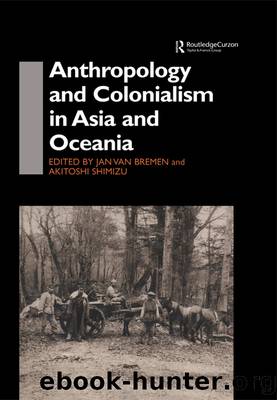Anthropology and Colonialism in Asia by Jan van Bremen Akitoshi Shimizu

Author:Jan van Bremen, Akitoshi Shimizu [Jan van Bremen, Akitoshi Shimizu]
Language: eng
Format: epub
Tags: Social Science, Ethnic Studies, General, Regional Studies
ISBN: 9781136105869
Google: 4nQsBgAAQBAJ
Publisher: Routledge
Published: 2013-03-07T05:46:27+00:00
Organisation and operation
While GotÅ was instrumental in defining the Commission's purpose and mobilising political support for it, Okamatsu was responsible for directing its research. Even more important is his role in synthesising the work of the Commission's many researchers, shaping their field reports and preliminary analyses into a comprehensive and coherent account of the socio-economic life of the Chinese of Taiwan. As an expert in comparative law, his intellectual leadership gave direction, conceptual unity, and analytical depth to the Commission's published reports. This section outlines the working of the Commission and examines Okamatsu's contributions.
The basic structure of the Commission was defined in imperial ordinance No. 196 of 1901. Nevertheless, as a task force it underwent periodic restructuring as the emphasis of its work changed over time.8 Its highest decision-making organ was a 15-member committee headed by the chief civil administrator, who was himself answerable to the governor-general. Initially, work was divided between two divisions (bu): the first in charge of the legal system (hÅsei) and the second (dainibu), the economy (nÅ-kÅ-shÅ keizai). Each division had a head leading a team of researchers, clerks and interpreters. Two years later the first division under Okamatsu evolved into two departments devoted, respectively, to the study of Taiwan's legal system (hÅsei ka) and the administrative procedures of Qing China (gyÅsei ka, Sakano, 1962). Expansion of the division's scope of research to cover Qing China was justified on the grounds that Taiwan's legal practices were rooted in the legal tradition of the mainland.
In 1905 the first division created a third department of economics (keizai ka) to take over the second division's research of Taiwan's economy. Meanwhile, the second division turned to the new task of investigating the economic conditions of South China, which was targeted by Japanese business interests based in Taiwan. Judging from research output, however, the second division appears to have ceased functioning after the reorganisation.9 Hence, in reality the expanded first division was virtually synonymous with the Commission, and its head Okamatsu became the de facto director of all research activities carried out under the Commission.
Another major organisational change took place in 1909 as work on the Han Chinese population was approaching completion. Turning its attention to the indigenous, non-Han inhabitants, the first division added a fourth department (banzoku ka) for the study of 'barbarian tribes' (banzoku). In a few years the project replaced research on the Han Chinese as the division's main concern. The whole project lasted about a decade (Kojima, 1979-80). At the same time a third division (daisanbu), also led by Okamatsu, was established to formulate colonial legislation on the basis of the first division's research. But after some ten years it managed to publish just 29 pieces of draft legislation - a level of productivity which hardly lived up to GotÅ's ambition for a comprehensive code for Taiwan. (It could not have accomplished significantly more after 1917 given that the Commission itself ceased to be active in the early 1920s.) While the research on the indigenous people and
Download
This site does not store any files on its server. We only index and link to content provided by other sites. Please contact the content providers to delete copyright contents if any and email us, we'll remove relevant links or contents immediately.
Cecilia; Or, Memoirs of an Heiress — Volume 1 by Fanny Burney(32434)
Cecilia; Or, Memoirs of an Heiress — Volume 2 by Fanny Burney(31871)
Cecilia; Or, Memoirs of an Heiress — Volume 3 by Fanny Burney(31856)
The Great Music City by Andrea Baker(31357)
We're Going to Need More Wine by Gabrielle Union(18967)
All the Missing Girls by Megan Miranda(15575)
Pimp by Iceberg Slim(14394)
Bombshells: Glamour Girls of a Lifetime by Sullivan Steve(13975)
Talking to Strangers by Malcolm Gladwell(13222)
Norse Mythology by Gaiman Neil(13207)
Fifty Shades Freed by E L James(13157)
For the Love of Europe by Rick Steves(13000)
Mindhunter: Inside the FBI's Elite Serial Crime Unit by John E. Douglas & Mark Olshaker(9201)
Crazy Rich Asians by Kevin Kwan(9167)
The Lost Art of Listening by Michael P. Nichols(7408)
Enlightenment Now: The Case for Reason, Science, Humanism, and Progress by Steven Pinker(7235)
The Four Agreements by Don Miguel Ruiz(6632)
Bad Blood by John Carreyrou(6552)
Weapons of Math Destruction by Cathy O'Neil(6146)
